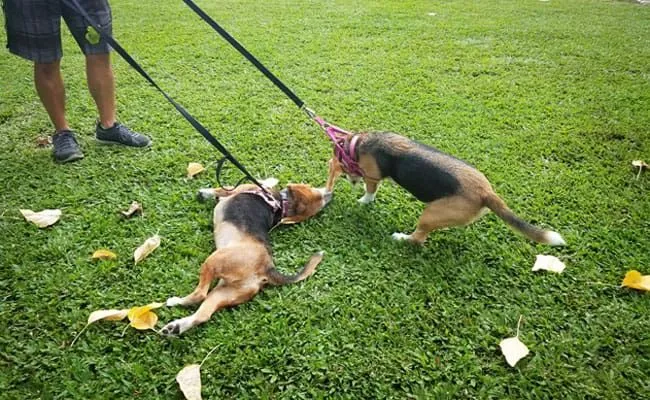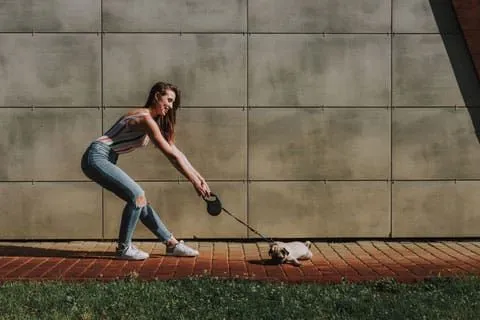Witnessing a puppy suddenly halt during a walk, refusing to move forward, is a common and often frustrating experience for many dog owners. It’s a scenario that can test your patience, especially when you’re trying to enjoy a pleasant stroll with your furry companion. While the immediate instinct might be to gently tug or even pull your puppy along, the question arises: Should I Pull My Puppy On A Leash? The short answer is a resounding no. This article will delve into why pulling your puppy is detrimental and offer effective, humane strategies to encourage them to walk cooperatively, transforming walks into an enjoyable experience for both of you. Getting your puppy to cooperate on walks is crucial, and understanding how to get puppy to stop pulling is a great first step.
Why Pulling Your Puppy is Never the Solution
When your puppy stops in their tracks, resisting the leash, resorting to pulling or dragging them is not only ineffective but also potentially harmful. Puppies have developing bones and joints, and force can lead to injuries such as strained necks, dislocated knees, or elbows. Beyond the physical risks, using force creates a highly negative association with you, the leash, and the act of walking itself. Instead of fostering a positive bond and a love for outdoor adventures, you could inadvertently instill fear, anxiety, and a deep-seated aversion to walks. Such experiences can make future training significantly more challenging and may even lead to behavioral issues.
Investigate the Root Cause: What’s Bothering Your Puppy?
Before attempting any training, it’s essential to act as a detective and determine why your puppy is refusing to walk. Their resistance isn’t stubbornness; it’s a form of communication. There might be an underlying issue that’s causing them discomfort or fear.
Environmental Factors
Consider the environment you’re walking in. Is the sidewalk too hot, cold, or rough for their tender paw pads? In winter, icy paths treated with salt or chemical ice melts can be painful and burn their feet. Similarly, during summer, asphalt can become scorching hot, leading to discomfort. Observe if your puppy consistently tries to walk on grass rather than the sidewalk, indicating a surface preference. Loud traffic, construction noises, or even a past traumatic experience (like a blaring siren) associated with a particular street can make a puppy hesitant. Pay close attention: Does your puppy only refuse a specific direction or route? If you turn around or choose an entirely different path, do they become more willing to walk? Being flexible and attentive to these subtle cues can help you pinpoint what’s causing their distress.
 Two puppies on leashes, one sits looking away while the other pulls slightly, on a grassy path.
Two puppies on leashes, one sits looking away while the other pulls slightly, on a grassy path.
Uncomfortable Gear
Your puppy’s walking gear could also be a significant factor. A collar that tightens painfully, or a harness that’s become too snug due to a growth spurt, can cause discomfort with every stride. A poorly fitted harness might rub against their skin or restrict their movement, especially around the elbows. Always ensure your puppy’s collar or harness fits comfortably and doesn’t cause any chafing or pressure points. Investing in a harness that’s more comfortable and fits better can make a world of difference. If they walk more willingly with different gear, you’ve found a key part of the solution.
 A Pug in a harness sits on a leash, looking back with a slightly stressed expression.
A Pug in a harness sits on a leash, looking back with a slightly stressed expression.
Physical Limitations and Health Concerns
In some cases, especially with brachycephalic breeds (like Pugs or French Bulldogs) or even large, flat-faced dogs, refusal to walk might indicate a lack of oxygen or overheating, making exercise difficult. If your puppy frequently stops, seems weak, or is panting excessively, consult with your veterinarian to rule out any underlying health issues. Even in other breeds, mild lameness or general fatigue could be a reason for their reluctance.
Make Walks Irresistible: Positive Reinforcement and Engagement
Once you’ve addressed potential aversive factors, the next step is to make walking with you the most exciting and rewarding experience possible. This means moving away from force and embracing positive reinforcement.
Start by practicing “walks” around your house or yard without a leash. Use an enthusiastic voice, high-value treats, favorite toys, and a playful demeanor to encourage your puppy to follow you. If you can’t capture their attention and keep them engaged in a familiar, low-distraction environment, it will be even harder outdoors. Make yourself more interesting than any distraction around!
Introduce an element of unpredictability to your interactions. Dash off playfully, hide briefly, and call them with an excited tone, perhaps leaving a small trail of treats for them to find. When they find you, lavish them with praise and affection. As you walk down a hallway, suddenly turn into a room and throw yourself onto a bed, inviting them to join you in a burst of joyful energy. Once your puppy is enthusiastically engaging with you at home, gradually take these games and positive interactions outdoors. The goal is to make being with you, even on a leash, far more attractive and rewarding than anything else in the environment. This consistent positive reinforcement will help you train your dog to not pull on leash effectively.
When All Else Fails: Carry Your Puppy Home
There will be times when, despite your best efforts, your puppy is genuinely overwhelmed, tired, or scared, and simply cannot continue. In these instances, the most compassionate and effective solution is to pick them up and carry them home. Just as a parent might carry a tired toddler, calling it a day is far better than forcing your puppy to continue. This approach avoids physical discomfort and maintains a positive association with you and walks, even if the walk itself was cut short. Remember, consistency in positive reinforcement and understanding their needs is key to happy, successful walks as they grow. Knowing when should i start walking my puppy on a leash can help set expectations early.
By understanding your puppy’s communication, addressing their discomforts, and making every outing an exciting adventure, you can build a strong bond and a happy walking companion for life.
